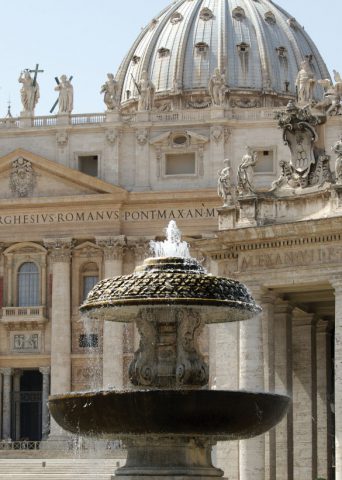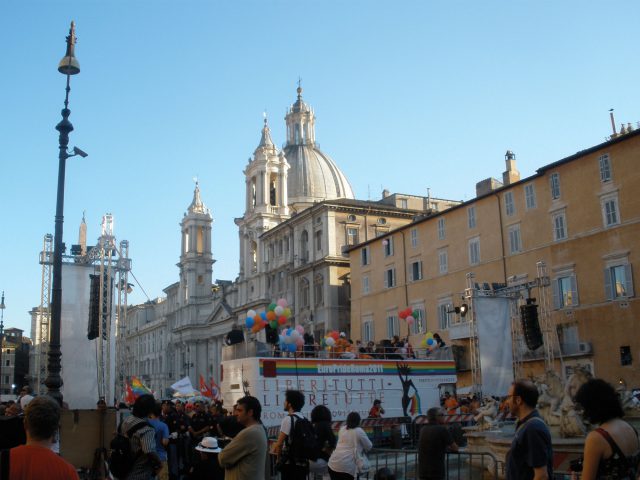Rome is a city built on the romance of legends, a passion for grandeur and an inextinguishable thirst for creation. The Roman gods smiled on the city of the seven hills, the heart of a once glorious empire, giving its inhabitants the drive and talent to build some of the world’s most architecturally and decoratively impressive structures. Today, walking the streets of Rome takes the traveler on a journey through millennia.
When in Rome, of course you must do as the Romans do and make your way to the Colosseum, the ancient world’s largest amphitheatre. In ancient times, more than 50,000 people from all over the Roman Empire would gather here to watch the gory, albeit crowd-pleasing, gladiator battles and chariot races.
Next to the Colosseum is the the Arch of Constantine, the largest triumphal arch in Rome. This structure was built to commemorate Constantine’s defeat at the Battle of the Milvian Bridge and it is decorated with reliefs narrating the life of the famed emperor. Not far from the Arc is the Forum Romanum, the ruins of Rome’s first forum, which includes the remains of many types of buildings, temples, and triumphal arches. The Arch of Titus, constructed in 81 A.D., stands on Via Sacra (sacred way), marking the passage into the city. The reliefs adorning the Arch of Septimius Severus, built in 203 A.D., depict the war between the Romans and the Parthians and are among the best preserved in the country.
A must-see in Rome is the Pantheon, which is arguably the most impressive building in all of Italy—maybe even in all the world. Built in approximately 27 B.C., the Pantheon has withstood several fires. It was renovated to its present form by Emperor Hadrian. The Pantheon was dedicated to the five planetary gods (Jupiter, Mars, Mercury, Saturn and Venus) and was inspirated by the magesty of ancient Greece, particularly its temples. Many tombs lie within the Pantheon, one of the most famous being that of Italian artist Raffaelo.
Another one of the most spectacular sights in the world is Saint Peter’s Basilica, world’s largest church, built over the tomb of Saint Peter. Its inside dates back to the Baroque period, but the façade is one of the most impressive structures built during the Italian Renaissance and is decorated with works by such canonical artists as Raphael and Michelangelo, the latter of whom is perhaps best known for his work on the Sistine Chapel. Commissioned by Pope Julius II to create a fresco spanning more than 10,000 feet, Michelangelo worked on the Chapel for four years. His famous touching hands tableau is now one of the world’s most often-referenced pieces of art. Michelangelo’s most well known sculpture and the only one that is completely finished and signed by the artist himself, the Pieta, also makes Saint Peter’s Basilica its home.
As you continue your explorations through Rome, a melodious and soothing sound will draw you to Trevi square, in the Quirinale district, near the Spanish Steps where you will find the Trevi Fountain, the city’s most beautiful fountain. Pope Urban VIII began a project to build a fountain in Trevi Square, originally meant to serve as the mouth of an aqueduct built in approximately 19 B.C to bring water into the expanding city, in the 1700s.
The Baroque fountain is erected around a statue of the mythological Neptune, the god of the sea, who is depicted riding a chariot made of shells and pulled by two sea horses. The sea horses, guided by Triton, reflect the mood of the sea: one calm and one in a fury. Two statues stand to the left and right of Neptune, representing Abundance and Health, respectively. Legend holds that that all who throw a coin into the fountain with their right hand and over their right shoulder will one day return to Rome. The superstition has proved beneficial to Rome, as all the money thrown in the fountain every night is collected and donated to varoius charitable causes.
A walk across the scenic Tiber River will take you to the Castel Sant’Angelo. Built by Emperor Hadrian as a mausoleum in 139 A.D., the castle served many functions throughout its past: it has been a fortress, the papal residence, a prison, and it is now a museum. A secret corridor connects the castle with the Vatican, but the more important hidden treasure is the café on the top floor of the castle, which offers a stunning view of the city.
As all of these sights and more make Rome one of the most popular tourist destinations, choosing accommodations from the hundreds available is no easy task. Right by the Colosseum is Hotel Altavilla (Via Principe Amedeo 9/B, hotelaltavilla.it), a budget-friendly alternative for those who want to be in the heart of the city, but don’t want to compromise the affordability of their vacation. This hotel is also ideal for sightseers, since it is located steps away from major transportation hubs, making it easy to take in all the sights Rome has to offer. A gay-friendly option is Hotel Eden (Via Ludovisi 49, edenroma.com), a 120 year old structure that towers over Rome’s Via Veneto and is just a short walk from the Trevi Fountain. A hotel for those travelers looking to spend some time pampering themselves, and each other, the Eden offers a variety of luxury amenities, including a spa.
Gay culture in Roma is similar to that in many other European cities: thriving, increasingly visible to straight society, and predominantly focused on big community events and nightlife. Rome’s annual LGBT celebration, Roma Pride (romapride.it), draws LGBT people and straight friends from across Italy and from all over the European continent. Rome’s bar scene has one particularity: most gay bars and clubs require that visitors be members of Italian gay rights organization Arcigay (arcigay.it), which requires a 20 euro registration fee.
Speaking of bars, if you’re going to Rome you’ll surely want to know about these: Frutta e Verdura (Via di Monte, fruttaeverdura.roma.it) is a mixed bar catering mostly to men which is also popular with women. Gorgeous I Am (gorgeousroma.it), Rome’s longest running gay club night and one of the city’s biggest gay parties, happens every Saturday at Alpheus (alpheus.it), a decadent space with five dance floors, each spinning a different type of music. Expect lots of sweaty dancing, rotating DJs and theme nights.
On the first Sunday of every month in Rome, a crew of lesbian nightlife promoters hold a theme party for women called The Venus Rising (venusrising.it). These ladies really go all out for their parties: think aperitivos, live shows featuring local performers and dancers, sexy burlesque acts—all to the spins of talented DJs. The Venus Rising parties change location every month, so prices and décor vary, but they always promise visitors a legendary time.
Glamorize is another party for women, going on every Wednesday at restaurant and bar 3 Joli (Via Tiburtina, 812, facebook.com/glamorize
.eventi?v=info). The perks of having any party in a restaurant, of course, include a great selection of local cuisine ready for your sampling pleasure, so you should make Glamorize your destination if you happen to be in Rome on the weekdays. You’ll find theme nights here, from Karaoke to drag shows to game nights, and you’ll definitely want to dress to impress those lovely Italian ladies.
Whether it’s the local gay nightlife you seek, or you’re looking for a lesson in history from the wonderous city of the seven hills, Rome will not disappoint. n







What Do You Think?